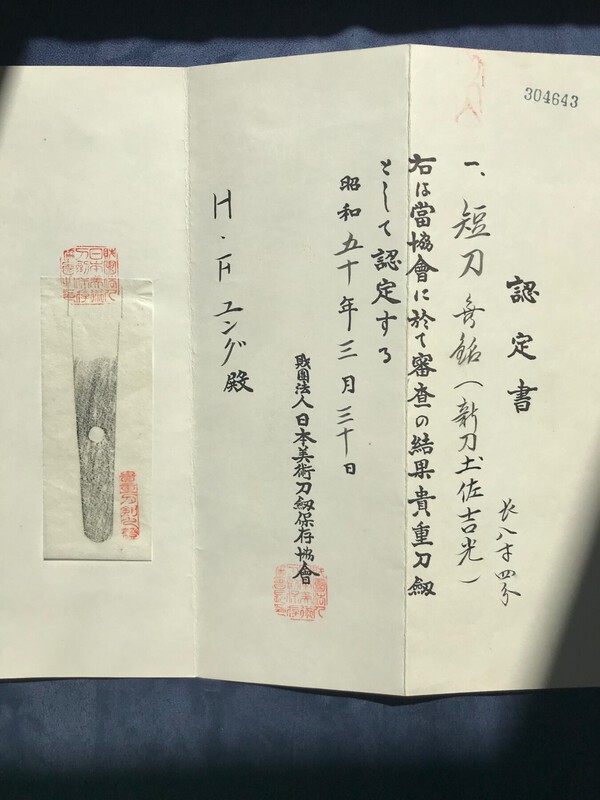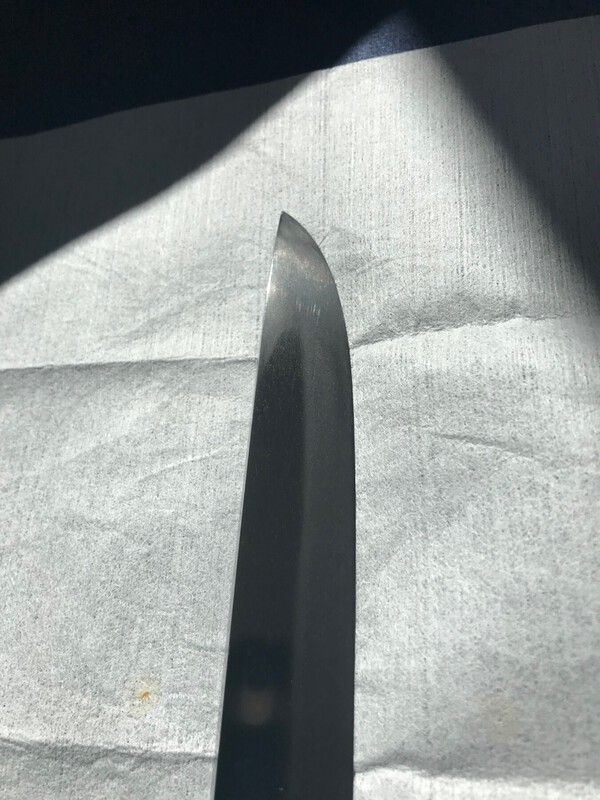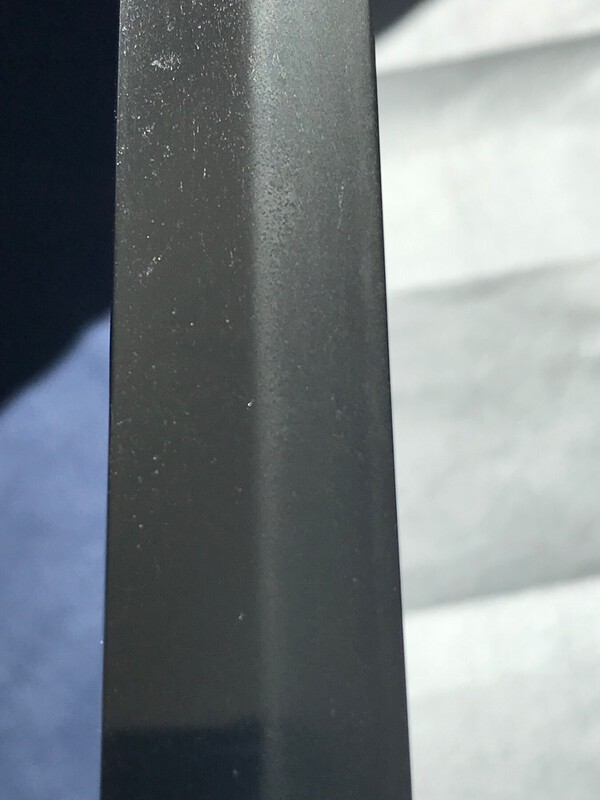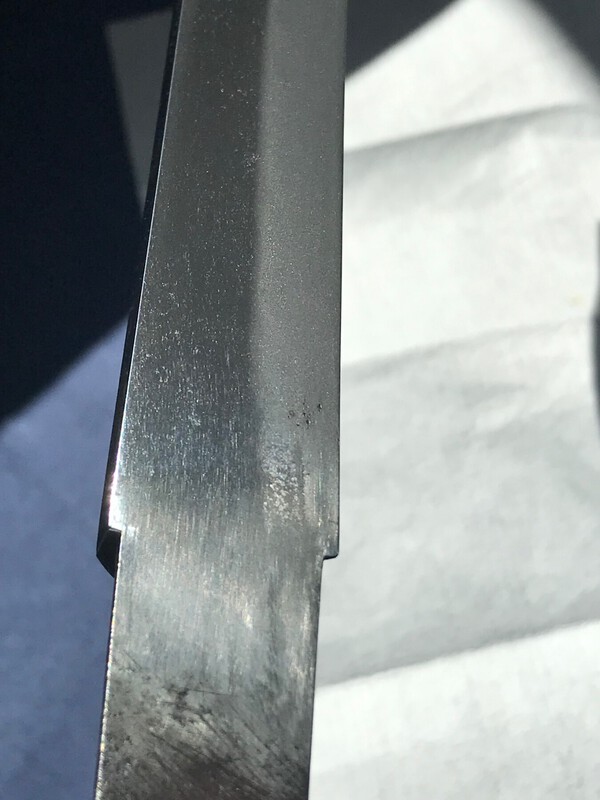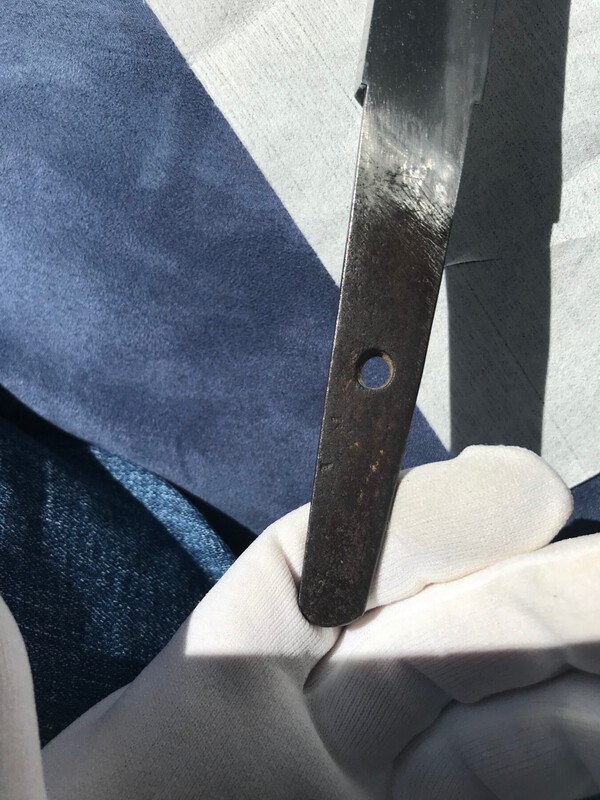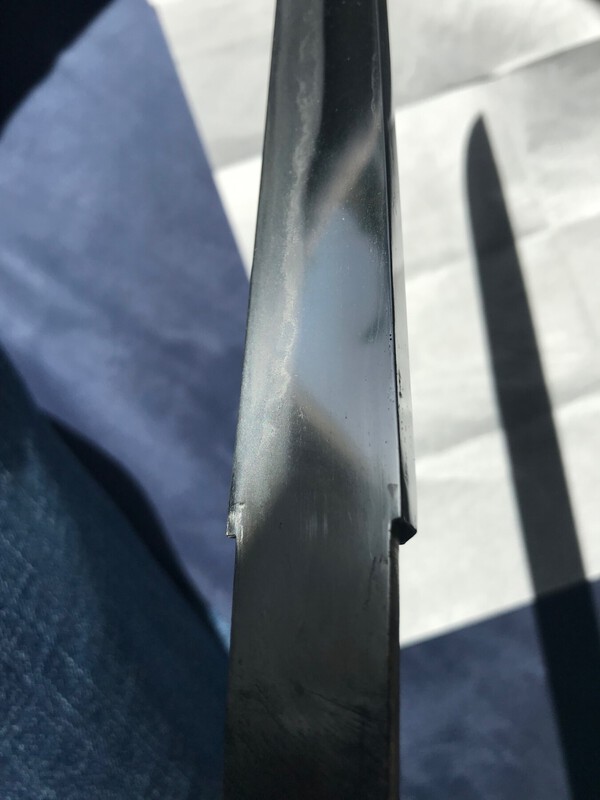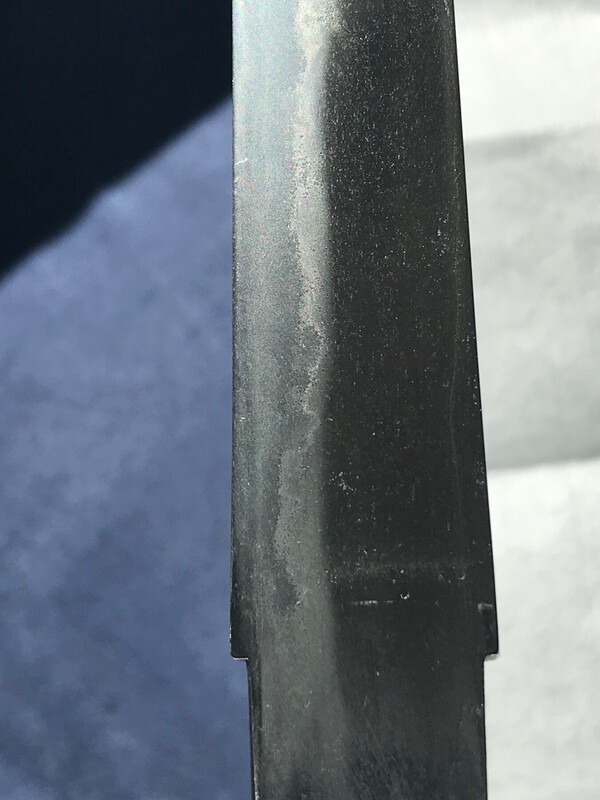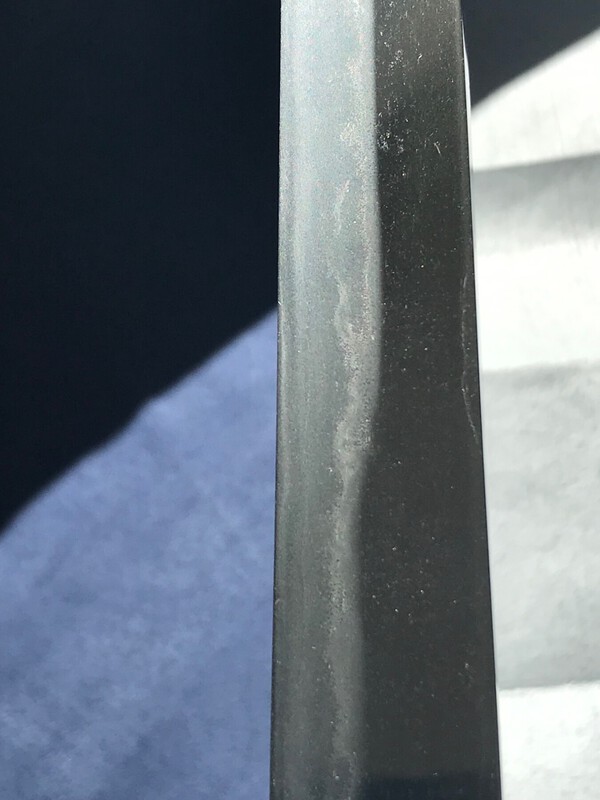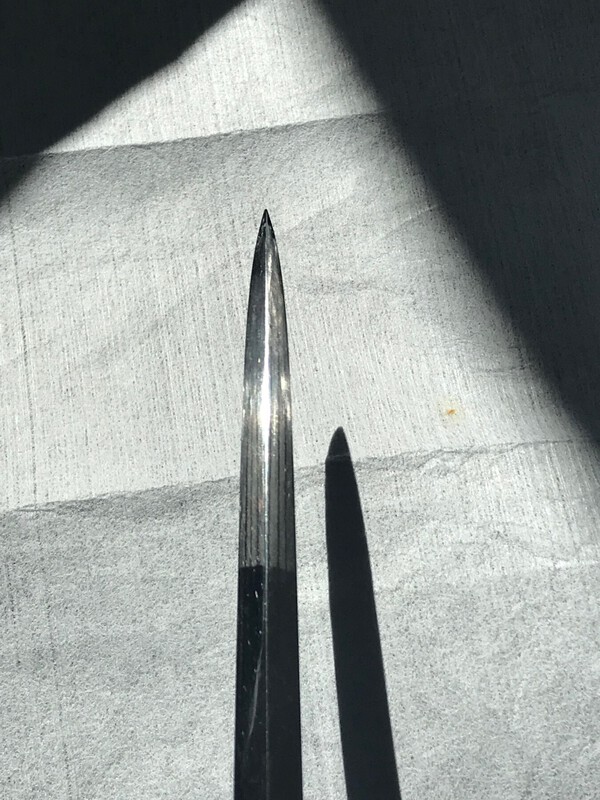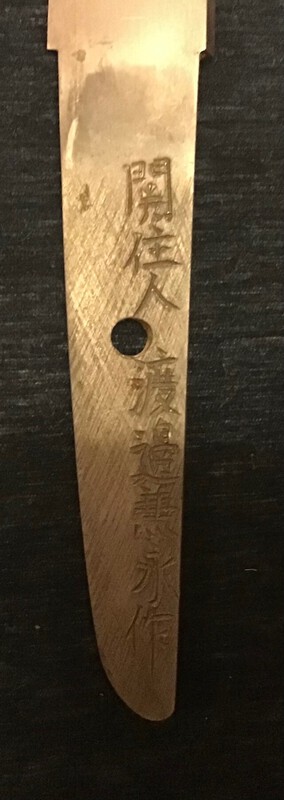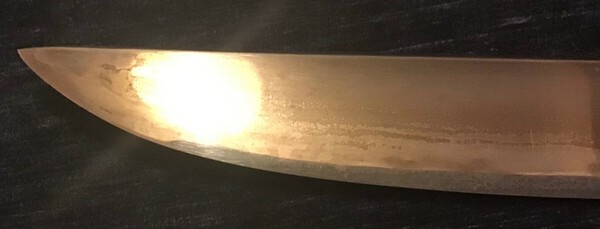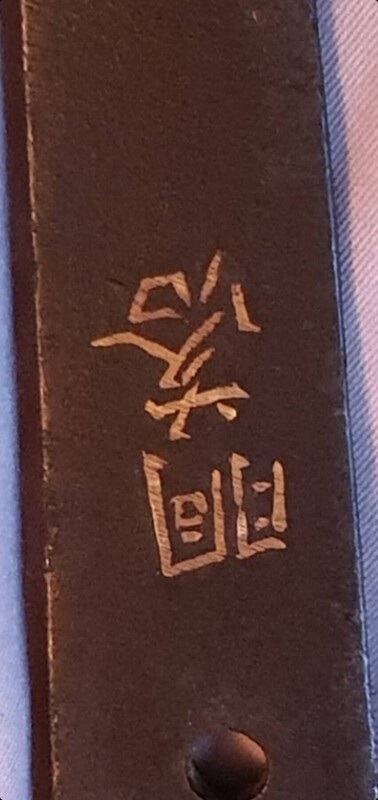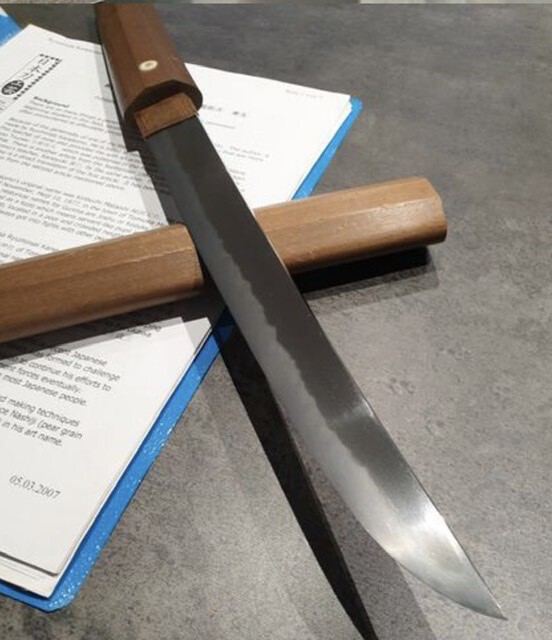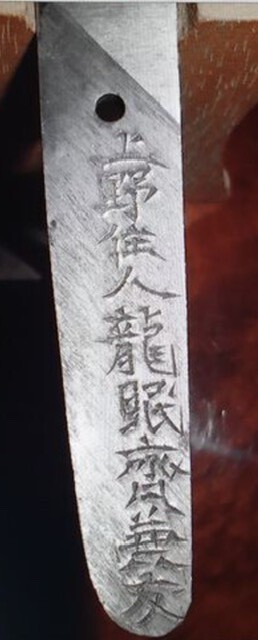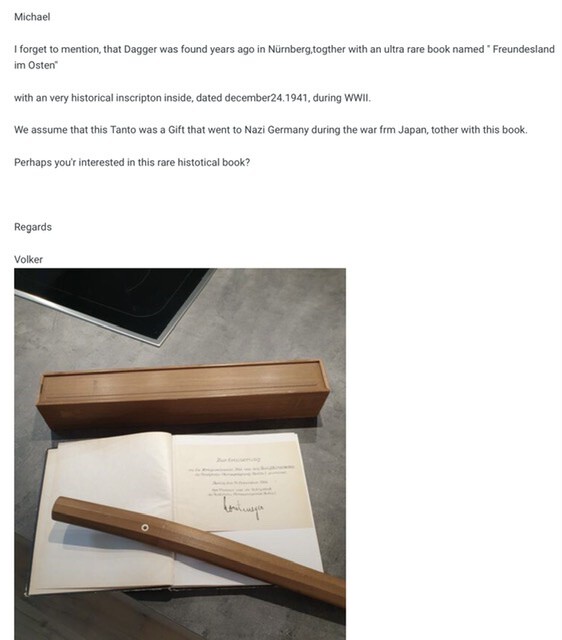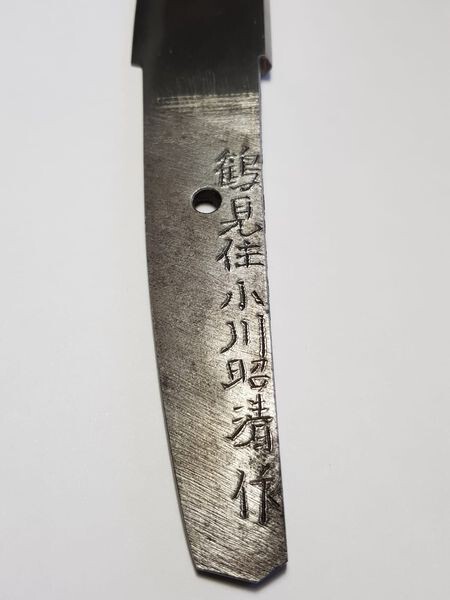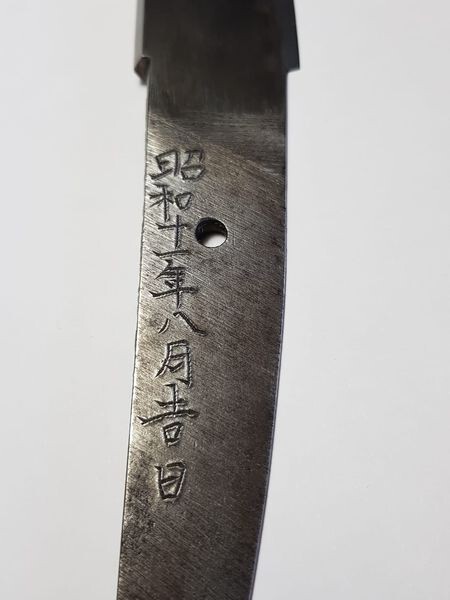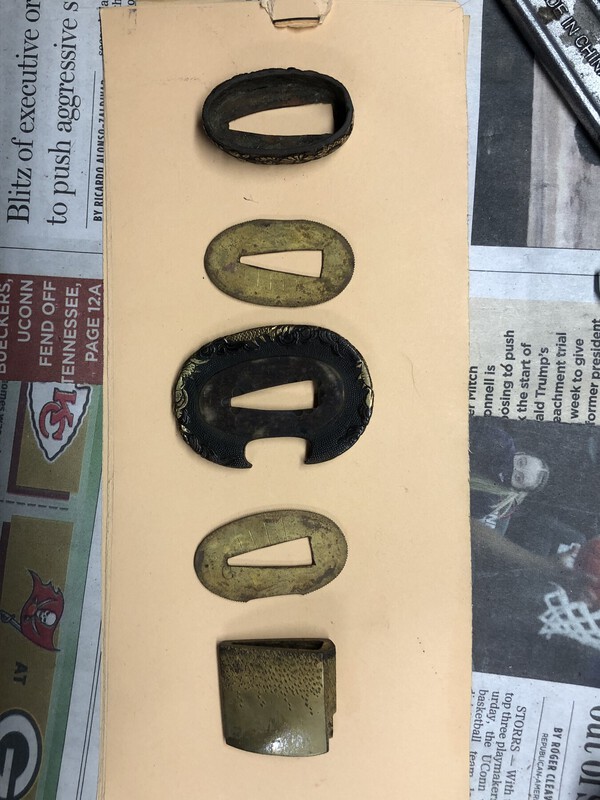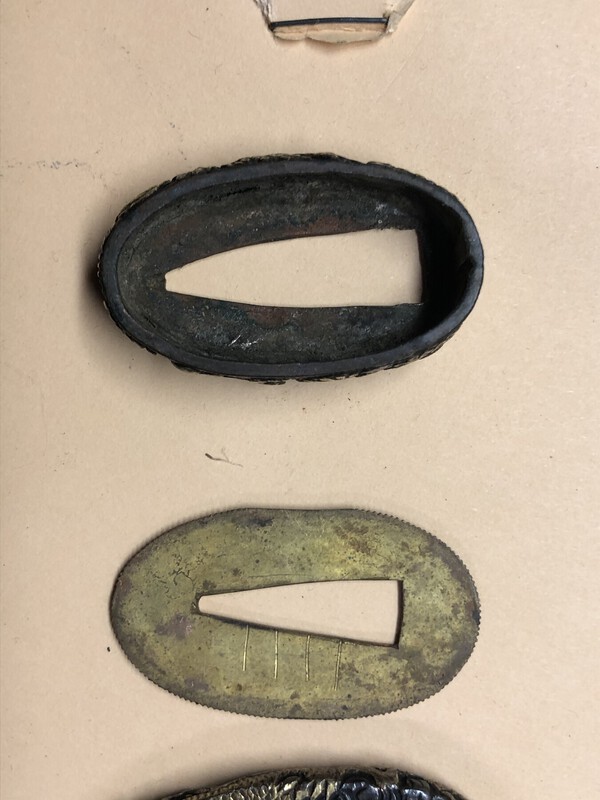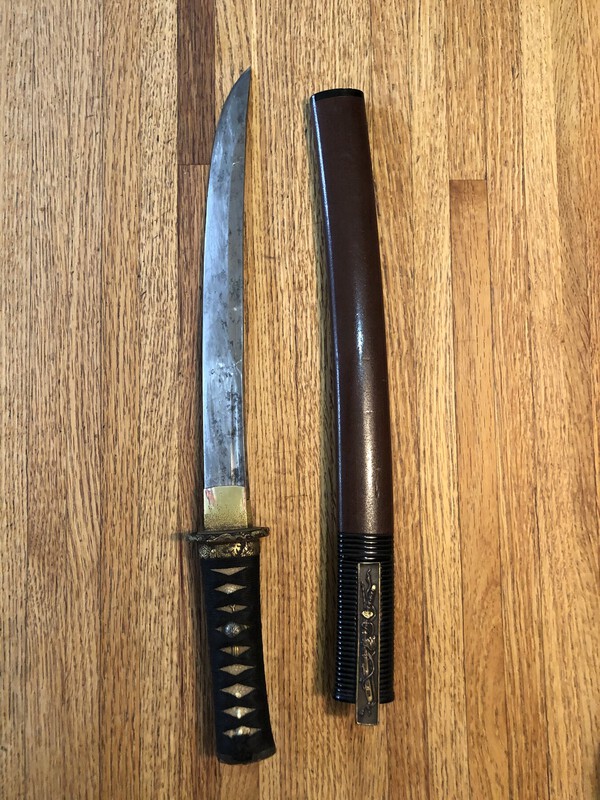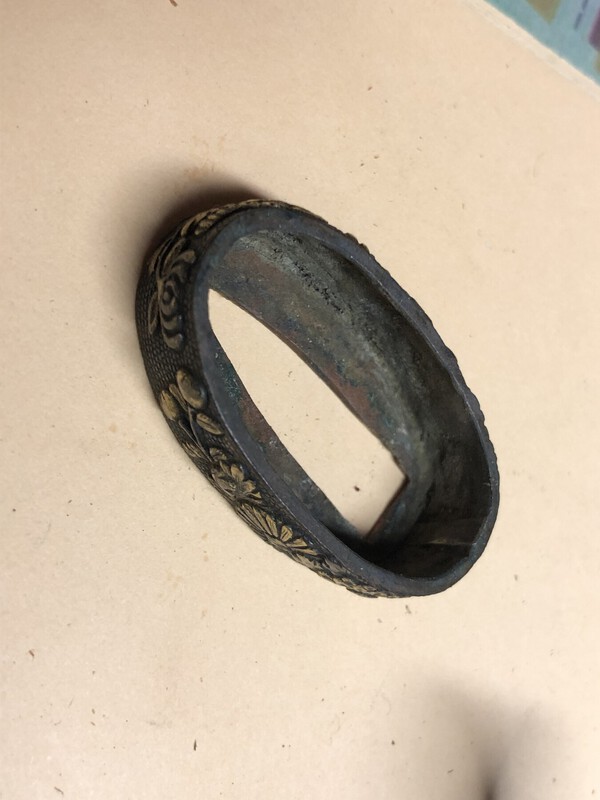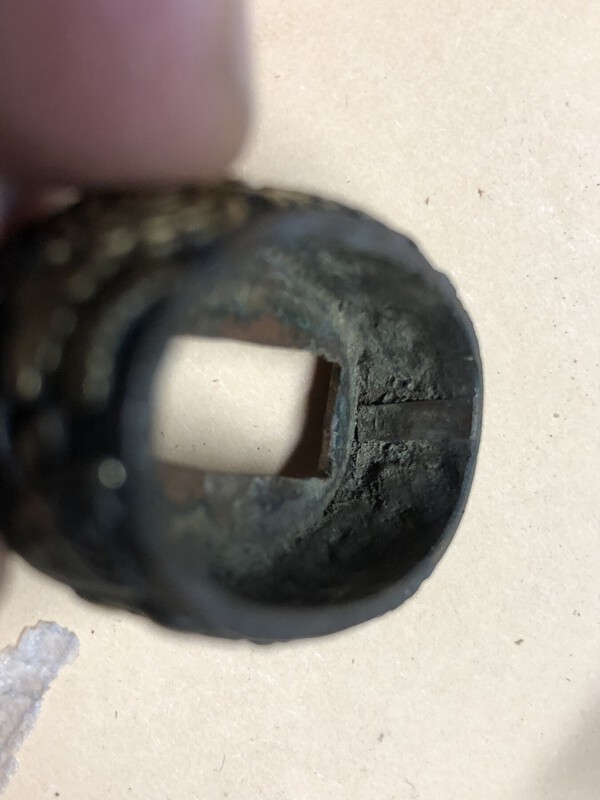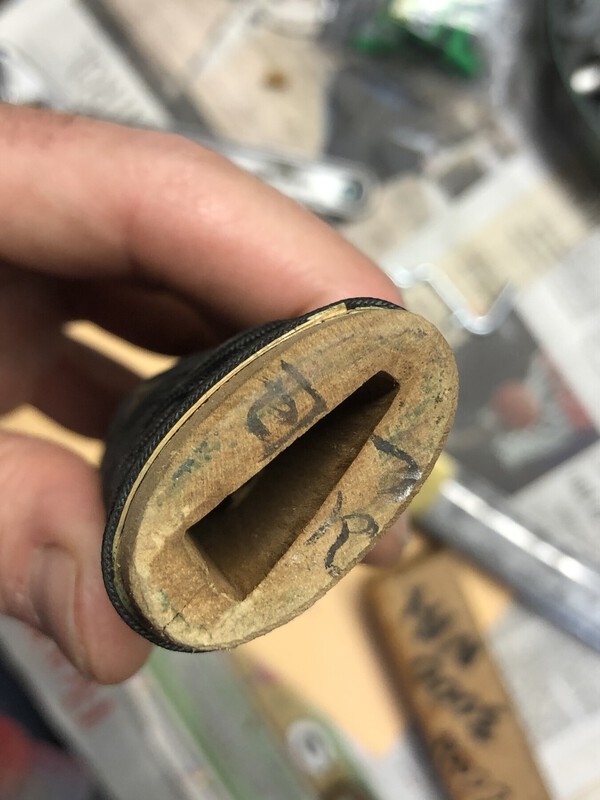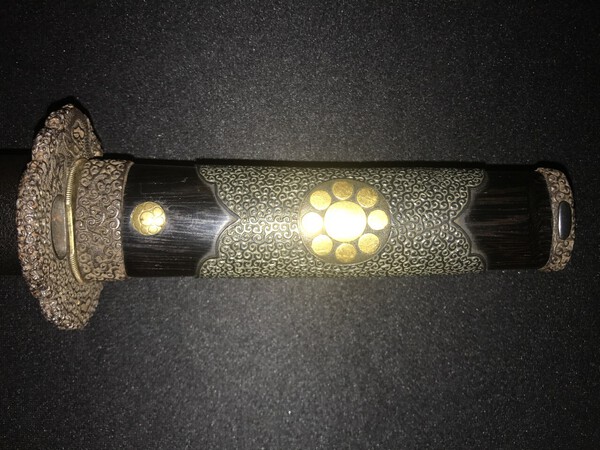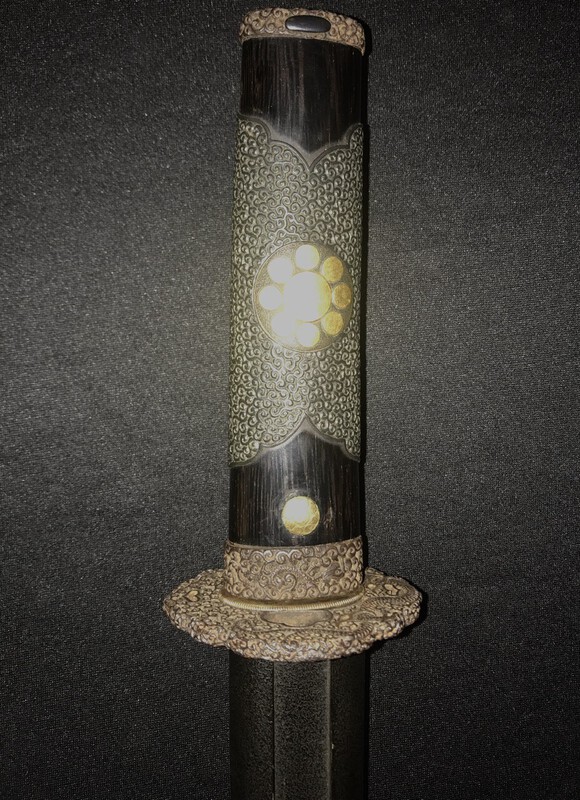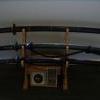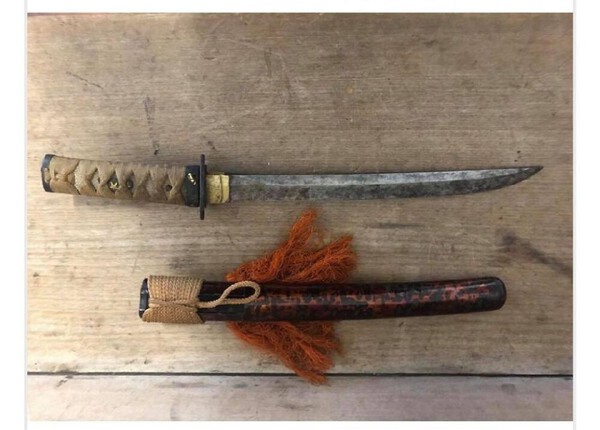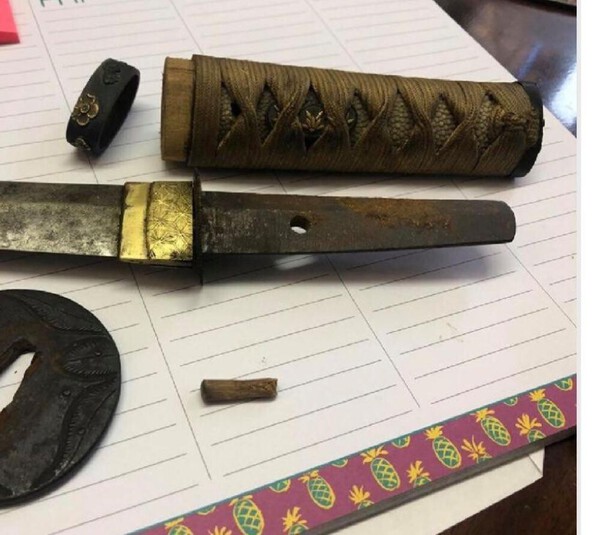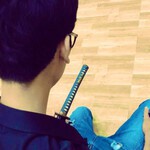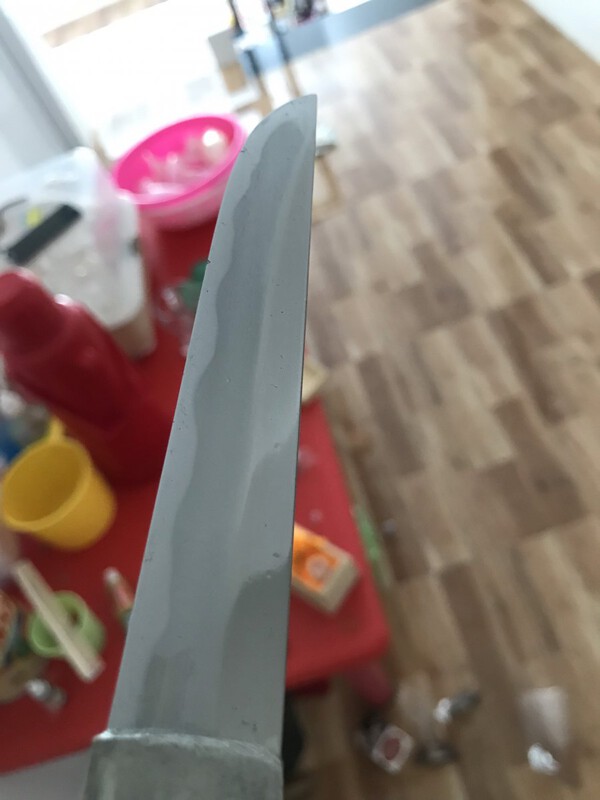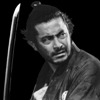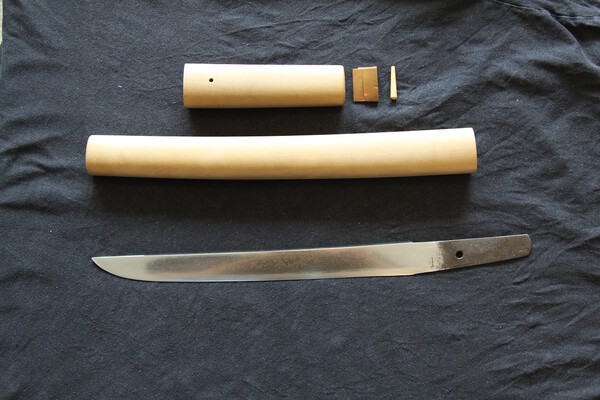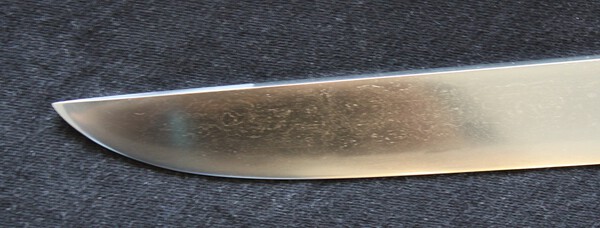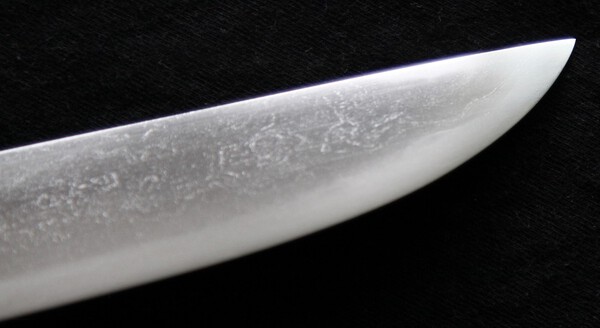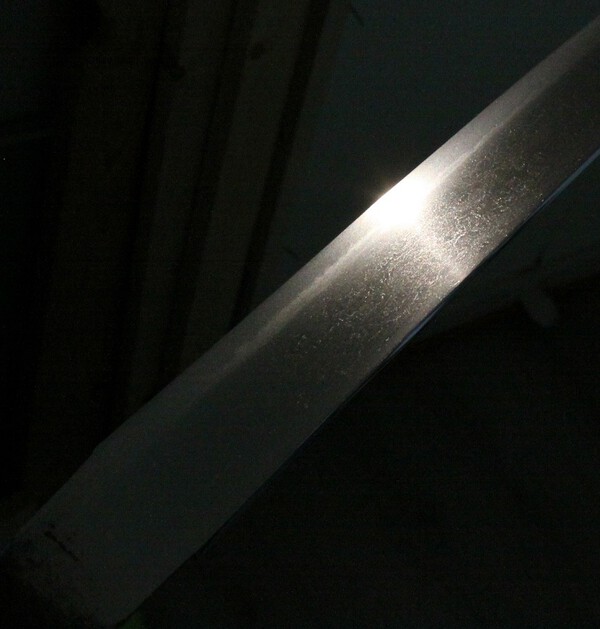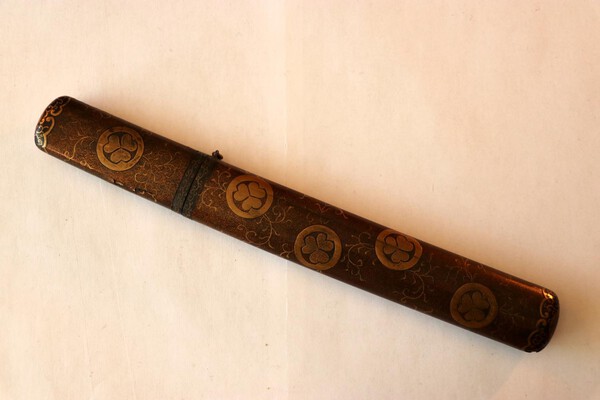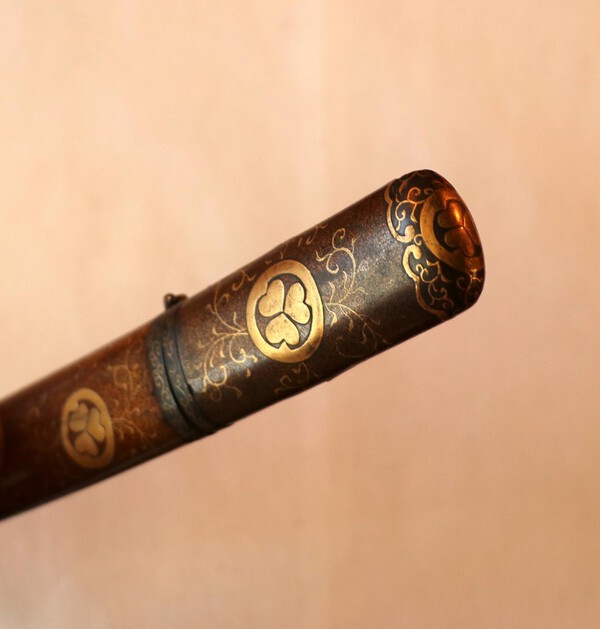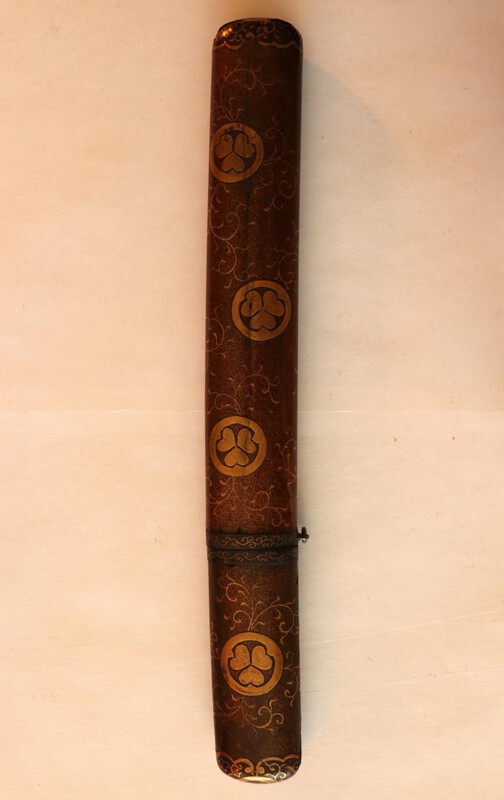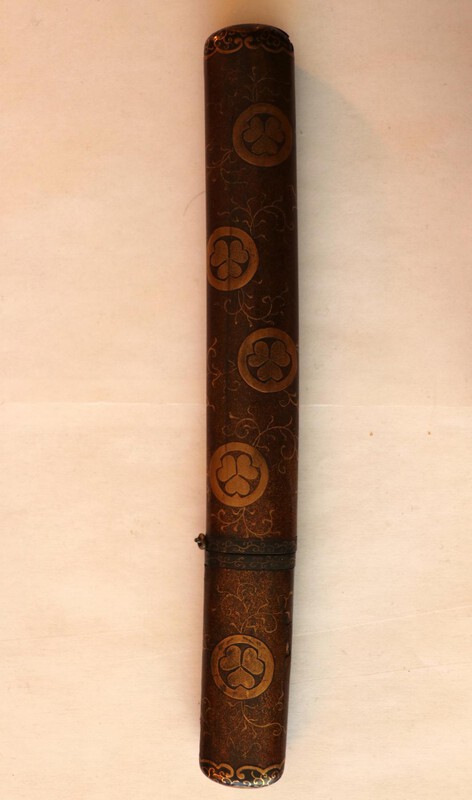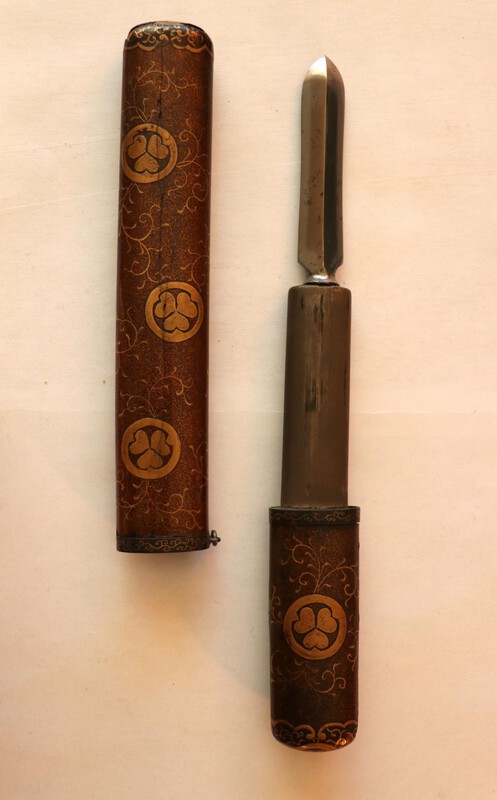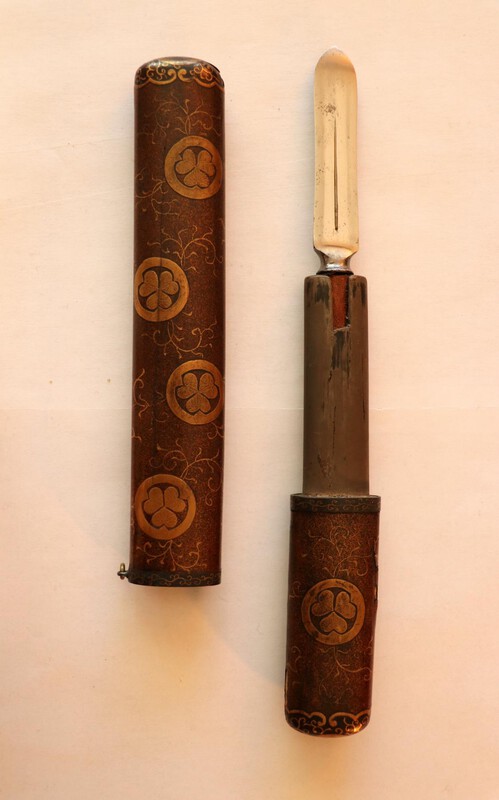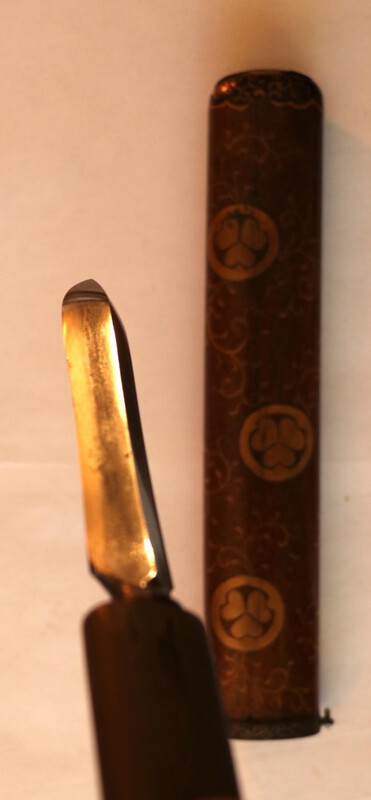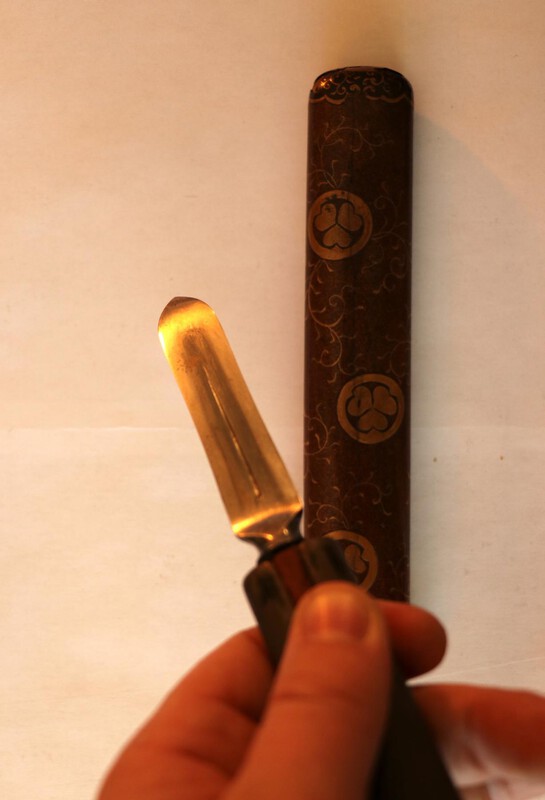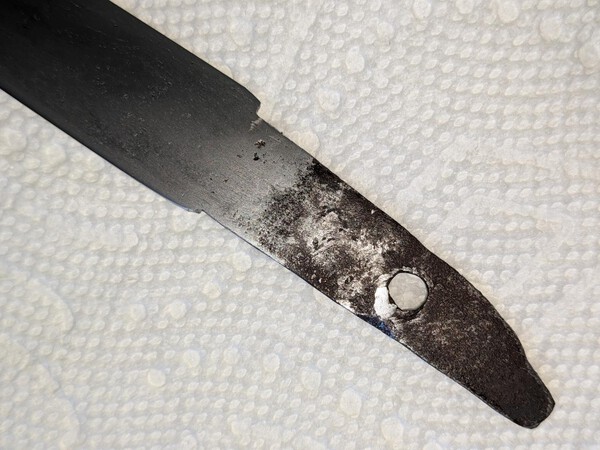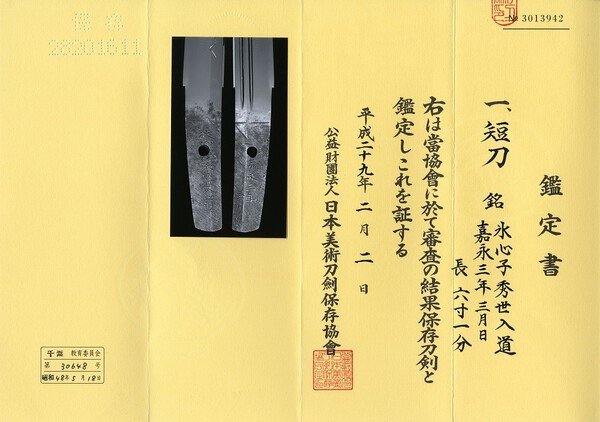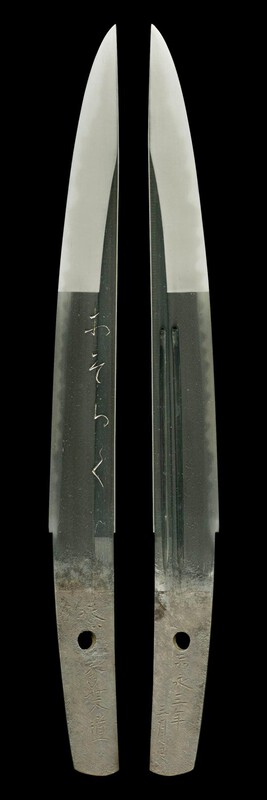Search the Community
Showing results for tags 'tanto'.
-
Dear NMB members, I have a fine tanto in yoroi-doshi (armor piercing) style. Mumei but apparently ascribed by NBTHK 30th March 1975 to (Tosa) Yoshimitsu if I’m reading the middle and last kanji correct? There have been several Yoshimitsu smith’s over time however, and I therefore need some help to translate and clarify both the first kanji but also my own interpretation of the name. Tanto specification: Nagassa: 254 mm, one punched mekugi ana (ubu nagassa / nakago) Sori: none Mune / hamachi: 10 mm Best regards Soren
-
I am not sure if I should post this here or in the General Nihonto forum. It is not a military sword but is (I think/hope) by a good Showa smith. If I have got it right it is signed “Seki ju nin Watanabe Kanenaga Saku”and dated 1937. It is in terrible polish….remains of perpendicular scratches etc and is in a shirasaya that someone has adapted to hold it. There is thankfully no serious damage though. They are not great images but I used the lighting that at least showed some of the visible activity. It certainly looks lively but it’s “had a life”. Personally I’ve never seen nie that “heavy” or pronounced(if it is nie) There are also clouds and streams of fine black konie that won’t show in the images scattered in the ji. The polish obscures the hada. Any/all comments or observations greatly appreciated. I’m just getting into later blades….there are some still in the UK! Nagasa 28.5cm (39.2 overall) motokasane 6.22mm (6.29 at thickest part of nakago)
-
St. Croix Blades website has been updated with New Japanese Swords. Click on the link to visit the site: https://stcroixblades.com/shop/Japanese-swords/ Also...swords in stock but not yet listed (but available): --Swords from the Plimpton Collection of Early Military Mount Swords --5 Gendaito: Ikkansai Kunimori, Haruhisa, Masashige, Nagamitsu, Masayasu --10-12 Nihonto in Samurai Mounts --NBTHK Tokubetsu Hozon Nanbokucho Sekishu Sadatsuna --50 Swords from a different collection of Early Military Mount Swords Sign up for our Store Newsletter to be Informed of our Newest Listings! Sign up at the bottom of the Home Page: https://stcroixblades.com/ --Matthew Brice St. Croix Blades
-
So, a few months ago I got this "old" tanto in a bad shape. It has a severe chip on the edge the polish is more or less scratched, one scratch is fairly long and well noticeable, the others are really fine, and even in person hard to see. As general information, it has a motohaba of 28,4mm and a motokasane of 6,9mm, the nagasa is 22,65cm, with a saki-sori of roughly 5-6mm. The blade itself is mumei, and has a slight amount of niku. The habaki fits very well and seems to have been made for the blade, it is a genuine "double"-habaki made out of two pieces, and copper if I had to guess, as this has some small pieces of verdigris on the inside. The second one is a little signed kogatana, which I acquired shortly after the tanto, and I am curious to know if the signature is genuine, given the bad shape it is in. It is 2mm thick, 12,6mm wide, and has a nagasa of 11,8cm. I hope to get an age estimation for both, maybe eben an estimate on quality. Generally, just some more information than the nothing I know currently. Maybe one or both are worth getting restored if possible, or is there a possibility to get both estimated professionally? I live in Germany, if this helps. Also, no, I won't touch either of this with anything than a cotton rag and oil.
-
Hello, I need some help. This the nakago of a little tanto. In my opinion, a work from the Muromachi period. I can read the first three characters : Bishu Osa (fune ?) .......then that was it. No idea what the other characters might mean. Does anyone have any idea what the remaining characters should mean ?
-
Good morning all, and yes it is a good morning. A couple weeks ago I posted my concerns about a recent Tanto purchase being stolen while in the care of the USPS. Well it arrived yesterday safe and sound. I want to thank all of you here that responded with their support. I also would like to thank the seller Volker from Germany for the great transaction, the extraordinary packing and the follow up with me and DHL. Let me say to others that may end up in the same situation, Don’t Give Up, Stay On The Shipper, Don’t Except that they Can’t Find Your package and close your case. I filed 5 claims on this package with the USPS. I had the claims expedited two times. During all of this the USPS sent me Two emails stating that they were sorry but my package was untraceable and lost. I then reopened my claims and made two calls to Consumers Affairs and filed claims with them. During this time Volker was also in touch with DHL. I believe that if we didn’t stay on the USPS and had accepted that they Couldn’t Find It I would have never received it. I still believe in being Pro Active in cases like this, when something doesn’t look right or feel right, get on it right away. If you feel it may be missing post pictures here so that all the good people can be on the look out for it if it should surface and most of all DO NOT EXCEPT THE SHORT ANSWERS THAT IT IS JUST LOST. Stay on it and push it. Again thank you all for your support, thank you Volker for the sale and all your help. I am Now the Proud New Caretaker of a beautiful blade that has finally found its way to its new home. MikeR
- 12 replies
-
- 16
-

-

-
Today is not a good day for me. After a week of trying my best with the USPS, that really doesn’t give a s***, they just informed me that my package is lost. I purchased this Tanto and Book from on of our members here on the forum in Germany. The package was sent to the USA via DHL and arrived in NY in 4 days. At that point DHL turned it over to USPS to deliver it, I still don’t know why DHL didn’t just deliver it themselves. I am in NJ and when I was informed that the package went from NY, one hour away to Indianapolis, 12 hours away I began calling the USPS. They didn’t care. SO NOW ITS GONE, AND THEY DTILL DONT GIV A S****. So here are the pictures I have and can only ask my fellow members to keep a eye out for this Beautiful Tanto and let me know if it shows up somewhere for sale. I wouldn’t normally do this but because I am devastated about this I am including my phone number and can be called at any time. I am not a wealthy person and have to choose my purchases wisely and this is very disheartening and a large hit to end and my finances. Please be on the lookout. This was originally post in the for sale section by Volker if you want to look at the complete description. Thank you all so much. Mike Roberts
-
-
Hi My newest nihonto I've spoken to Paul B and he has given me a few pointers and I hope to show it to him when Covid permits In the meantime I welcome any comments especially seeing how accurate the kantei exercises have been over the last few weeks And finally to Shinsa or not to Shinza that is the question? Details: An Ubu hira-zukuri tanto, iori mune with no sori. The hada is of itame and Mokume type. The hamon is a shallow midare/gunome in nioi deki. There is some evidence of activity such as sunagashi (Sunagashi= drifting sands- it describes activity within the hamon where lines of nie join together and flow parallel to the hamon. It looks a bit like masame hada inside the hamon running through the hamon. The boshi is sugu and narrow possibly the kissaki has been reshaped. There is no kaeri evident. The nakago appears to be ubu it is short and slightly funa-gata in appearance and ends in a ha-agari kurijiri. The Yasurime appear to be kiri but not clear. The polisher added: It’s a nice Tanto and lots of activity, the hamon at the kissaki was really unusual and two different colours of steel so at first I thought it was utsuri.
-
Hi all If someone's Japanese is better than mine, I would be happy to get a complete translation. Tanto was made by Akikiyo? At Kurihara Hikosabur's Nihonto Denshu Jo...... Thanks Volker
-
Hello, I’m hoping someone might be able to tell me some information about this tanto. My grandfather brought it back from Korea, (with written permission), during WWII. He never spoke about it but it was passed on to my father when his father died. Neither of us know anything about it. I removed the tsuka to check for an inscription, but unfortunately I don’t see anything. Just the writing on the end of the tsuka itself. Can anyone translate that? Also, one of the small gold-colored pieces has four lines scratched into it. What could that signify? Any information you could provide would be helpful, thanks!
-
Very fine gold and shakudo Hosakawa motif tanto koshirae available. This koshirae has a elaborate matching Namban iron fuchi, kashira, and tsuba. The finely carved shakudo handle wrap is of the same matching design. The Hosakawa menuki are fine shakudo and gold. The fuchi, kashira, and tanto each have a dragon in their intricate carving. This koshirae holds a 9” to 12” tanto blade. CONDITION: This rare koshirae is in exceptional condition. $2400
-
-
-
Hi All, Merry xmas to all and wishing everyone a better year for 2021. It only can get better. A tanto project recently completed and returned from Thomas Buck. Period Tsuba, Fuchi and Kashira , Menuki, seppa supplied by me. Regards Chris NZ
-
Just joined but wanted to share and ask about this Tanto I won at auction, love the shape of blade but the lacquer work is interesting. The tang is mumei, with one hole and the fittings are I think cherry blossoms, some are gold plated. Tshuba is iron and incise carved and if I had to guess the blade would date to 1700's maybe earlier, the color is more gray (friend calls it "sand iron" but that may not really be a term. Either way just sharing for enjoyment and comments. Also, does anyone recognize the Mon in center disc of minuki?
-
Hello, i recently purchased this tanto in a auction in Maine. it is signed but i cannot read the signature, can anyone help me learn a bit more about this piece. the only thing the seller knew was that it was brought back from ww2. thank you!
-
Hello friends! i am a beginner ... I own a tanto bar but I don't know anything about it! Please let me know what you think about it! my ignorance desperately needs your enlightenment ...! Please 😶
-
-
Hi guys, First time I request your help for a sword. I gotta confess that I’ve never been foo much into tanto and only skimmed through the sections about them in books. But I needed one in my collection and so when a cheap one was offered in the sale section, I jumped on the occasion. I know, I know, get the best you can afford, but I didn’t follow the rule and well, here it is! I was extremely surprised because I was expecting something less. Just a big knife, but fou d out a beautiful piece and I have to say if this is the case with all tanto, it may well have changed my mind about them. anyway, since then, I’ve been doing some catch up and read everything I could find about them, trying to label it. But I must admit that I’m still at a loss. When you read the essays, I sounds pretty easy but then I compared with some being sold on sites and dated and realized that exceptions seem to be the rule. So, here I am, needing your help! I may do it another time with a mumei sword I have, but for the moment, let’s concentrate on that tanto. Now, I’ve been around long enough not to ask "who" made it. Yet, if you could give me a rough date and style, I’d be more than happy. So far, I’ve had three opinions: mine, likely false, thinking early Bizen Muromachi because of the length. The seller who thinks Bizen early Shinto and another member who thought Bizen originally then pointed me towards Sue Mino. I checked, and that could indeed fit the bill. The tanto specs follow: Mumei in older shirasaya. Overall length: 40,2 cm Nagasa: 29,2 cm Moto kasane: 6 mm Moto Haba: 30 mm Shape: Hira Zukuri, iori mune with gentle oroshi. Sori: 2 mm, tends to be slightly koshizori Yasurime: kiri. Very visible near the habaki, almost gone the further we get from it. The color of the nakago is very dark grey/ brown, almost black. Hada: predominantly mokume. Hamon: based on Suguha, bright nioi. I don’t see any utsuri or my eyes aren’t trained enough Below, I’ve included pictures and an oshigata I’ve made to help you see the Hamon. I think it is quite faithful. I haven’t had time to take pictures myself, but if required, will do my best. Thank you for your help, JP
-
Hi Everyone, I recently got an interesting yari off ebay but it is mounted in a tanto koshirae. It has very impressive lacquer work but the lacquer is cracking, has flaked off in places and it looks like at one point someone used a sharpie to blacken some missing spots that have now grown. I would love to get the yari out and see if it's signed but I am not sure that will ever happen since there does not seem to be a mekugi, it could be glued in, I am not sure. It is so delicate in places I am scared every time I handle it, is there anyone who could correctly get this restored or just stabilized that forum members know of? Maybe this is not the kind of thing that should be messed with at all and just preserved as best it can be as is. On a more general topic, has anyone seen yari mounted like this before? I remember reading somewhere that it was popular in the 1800's to repurpose mounts/mediocre blades to export. I would love opinions as to if this could this weird mounting style be a result of that or could it be a genuine mounting of something earlier? Thanks for your time and ideas. -J.G.
-
I'm still getting use to using this message board, so I apologise if I do anything wrong. I am also fairly new to the nihonto community, so I don't know very much. I bought this tanto online, and I am wanting help identifying it, or determining how valuable it is. The seller claimed it was edo era. It is very short and thin. It is mumei, but looks like there may have been some kind of markings at one point. I didn't spend too much on it, as it was in really bad shape. I received it with the tip broken off completely, with several chips. As far as the koshirae goes, the saya was in ok shape. The habaki was cracked and scratched from what looks like someone removing the handle recklessly. The tsuka had been repaired before, and had since been eaten by termites. The stingray skin wrap was put on backwards. The kashira was missing, and the fuchi was carved out of the handle to look like horn, but is all really one solid piece. Given the state of the knife, I felt comfortable giving it a little bit of polishing, just enough to see what I think is the hamon. I can only really see what I think is the hamon on the ura side, but I'm not wanting to remove too much material, in case it is worth sending to a polisher. I cleaned up the tip and re-shaped it. Any help would be appreciated
-
This interesting and highly collectable shin-shinto Osorakuzukuri shaped tantō is signed Hyōshinshi Hideyo Nyūdō氷心子秀世入道 and dated Kaei sannen sangatsu nichi (a day in March of 1851) 嘉永三年三月日. Hideyo is rated Jō-saku and this tanto is accompanied by a NBTHK Hozon paper. Price: Yen 270,000 (including delicensing out of Japan and shipping to EMS destinations; however, payment to be made by wire transfer only ...sorry about that!) Currently EMS shipments are delayed but there is movement of the backlog..... Details Nagasa: 18.6 cm Sori: 0.0 Moto-haba: 24.8 mm Saki-haba: 21.9 mm Moto-kasane: 3.7 mm Saki-kasane: 3.0 mm The hamon is gunome-midare with a tight nioiguchi, the bōshi hakkikake, the jigane looks soft, and the jihada is ko-itame-nagare. On the omote are the hiragana engraved for osoraku おそらく, while the horimono on the ura represent gomabashi. Hyōshinshi Hideyo’s 氷心子秀世 real name was Tamura Kōhei 田村耕平. He was a student and son-in-law of Suishinshi Masahide 水心子正秀. He also studied under Unju Korekazu 雲寿是一. His dated blades are from Tenpō (天保 1830-1844) to Ansei (安政 1854-1860) eras. It is a mystery why he added a small stroke to the first kanji of the Suishinshi (水 → 氷), which reads Hyōshinshi. He also occasionally signed his mei with the additional nyūdō 入道 signifying Buddhist lay priest. His residence was in Edo’s Azabu-Imazato 麻布今里. Robert Hughes (correspond with me at keichodo@yahoo.com) If it sells, a donation to NMB will be made!

